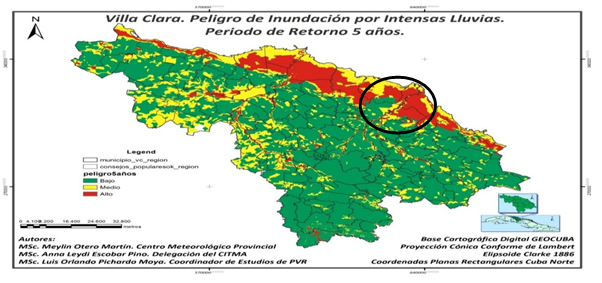Action plan to counteract the impacts of climate change in vulnerable areas in Camajuaní
Main Article Content
Abstract
The effects caused by climate change constitute a concern of the Cuban State, where the ability of communities to adapt to the impacts that thisgenerates is an aspect of great interest. The purpose of this research is to propose an action plan aimed at the implementation and control of the State Plan "Tarea Vida" in the search for adaptation and mitigation of the effects of change in vulnerable areas of the Camajuaní municipality, based on encouraging the joint participation of the communities involved, the local government and companies and institutions. For this, theoretical and empirical methods were used, such as analysis and synthesis, inductive-deductive, documentary analysis, group work, ecomap and direct observation. As main results, the diagnosis of the current situation of hazards, vulnerabilities and risks was obtained, by communities of the municipality, which served as the basis for the design of an action plan in the short, medium, long and very long terms, focused on counteract their impacts in prioritized areas given their danger and vulnerability scenarios. The foregoing serves as an essential reference for the design and implementation of local policies and strategies, for the mitigation and adaptation to climate change.
Article Details

This work is licensed under a Creative Commons Attribution-NonCommercial 4.0 International License.
References
Cardoso, M. M. (2019). Estudio de la vulnerabilidad y la resiliencia en la ciudad de Santa Fe, Argentina: El rol de los servicios urbanos en general y del transporte de pasajeros en particular. Revista de Geografía Norte Grande, (73), 133-159.
CESAM (2019). Centro de Estudios y Servicios Ambientales de Villa Clara. Estudios de peligro vulnerabilidad y riesgo del municipio de Camajuaní. Villa Clara, Cuba.
Cervantes, R. I. C., & Martínez, S. A. (2021). Estrategias sustentables para Cd. Loreto BCS; humedales artificiales y propuesta vegetal para resiliencia y desarrollo local. Regiones y Desarrollo Sustentable, 21(41).
Ciscar, J. C. (2020). Impactos del cambio climático en España: Una revisión parcial. Papeles de Economía Española, (163), 2-201.
CITMA (2017). Ministerio de Ciencia, Tecnología y Medio Ambiente.Enfrentamiento al cambio climático en la República de Cuba. La Habana. http://repositorio.geotech.cu/jspui/bitstream/1234/2864/1/Plan%20de%20Estado%20para%20el%20Enfrentamiento%20al%20Cambio%20Clim%C3%A1tico%20en%20la%20Rep%C3%BAblica%20de%20Cuba%20%28Tarea%20Vida%29.pdf
FerreraBergues, A., Pérez Montero, O., & Soler Nariño, O. (2020). Población y vulnerabilidad social ante los efectos del cambio climático en el municipio costero de Guamá. Revista Novedades en Población, 16(32), 242-269.
Marrero, D. R., Salcedo, M. G., Crespo, C. M. M., & Téllez, J. C. R. (2019). La universidad y la educación para el cambio climático. Humanidades Médicas, 19(3), 427-443.
Olivares-Cerpa, G., Russo, B., Martínez-Puentes, M., Bladé, E., & Sanz-Ramos, M. (2022). “SUDS-lineales” para reducir el riesgo de inundación considerando escenarios de Cambio Climático. Ingeniería del agua, 26(2), 77-90.
Sálmon-Cuspinera, Y. Z. (2020). Impactos y riesgos de los eventos climáticos extremos en el sector agrícola de la provincia Santiago de Cuba, Cuba. Ciencia en su PC, 1, 99-112.
Sánchez, G. E. C., González, A. L. M., & Benavides, L. O. B. (2020). Paradigmas mixtos: interpretativo y crítico en estudios sobre cambio climático. Una ruta para co-construir resiliencia social. IE Revista de Investigación Educativa de la REDIECH, 11, 712.

